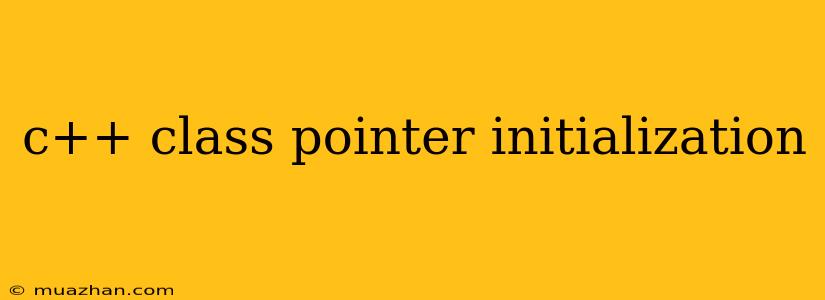C++ Class Pointer Initialization
In C++, class pointers are powerful tools for working with objects dynamically. They allow you to create objects on the heap, manipulate them from different parts of your code, and manage memory effectively. However, understanding how to initialize class pointers correctly is crucial to avoid common errors and ensure the integrity of your program.
Understanding Class Pointers
A class pointer is a variable that holds the memory address of a class object. To declare a class pointer, you use the asterisk (*) operator followed by the class name and the pointer variable name:
ClassName* pointerName;
For instance, to declare a pointer to a class named MyClass, you would write:
MyClass* myClassPointer;
Initialization Methods
There are three main ways to initialize a class pointer:
1. Null Initialization:
The most basic initialization assigns the pointer a null value, indicating it doesn't currently point to any object:
MyClass* myClassPointer = nullptr;
2. Dynamic Allocation using new:
This method creates an object on the heap and sets the pointer to its memory address:
MyClass* myClassPointer = new MyClass; // Creates a MyClass object on the heap
You can also initialize the object's member variables using constructor arguments:
MyClass* myClassPointer = new MyClass(value1, value2);
3. Initialization with an Existing Object:
You can assign a class pointer to the address of an existing object created using the new operator or declared as a regular object on the stack:
MyClass myClassObject; // Object on the stack
MyClass* myClassPointer = &myClassObject; // Pointer to the existing object
// Or with an object created on the heap:
MyClass* myClassPointer = new MyClass;
Important Considerations:
- Memory Management: When using
newto create objects dynamically, you are responsible for releasing the memory using thedeletekeyword to prevent memory leaks. - Dangling Pointers: Be cautious of dangling pointers, which occur when a pointer refers to memory that has been deallocated.
- Null Checks: Always check if a pointer is null before attempting to access the object it points to, to avoid segmentation faults.
Example
#include
class MyClass {
public:
int value;
MyClass(int val) : value(val) {}
};
int main() {
// 1. Null Initialization:
MyClass* myClassPointer1 = nullptr;
// 2. Dynamic Allocation using new:
MyClass* myClassPointer2 = new MyClass(10);
// 3. Initialization with an Existing Object:
MyClass myClassObject(20);
MyClass* myClassPointer3 = &myClassObject;
// Accessing the object through pointers:
std::cout << "Value of object pointed by myClassPointer2: " << myClassPointer2->value << std::endl;
std::cout << "Value of object pointed by myClassPointer3: " << myClassPointer3->value << std::endl;
// Releasing memory for dynamically allocated objects:
delete myClassPointer2;
return 0;
}
Conclusion
Initializing class pointers correctly in C++ is crucial for effective memory management and program stability. Using the right techniques and understanding the potential pitfalls helps ensure your code operates as intended. By adhering to good practices and carefully considering the type of initialization required, you can leverage class pointers to create robust and efficient programs.
